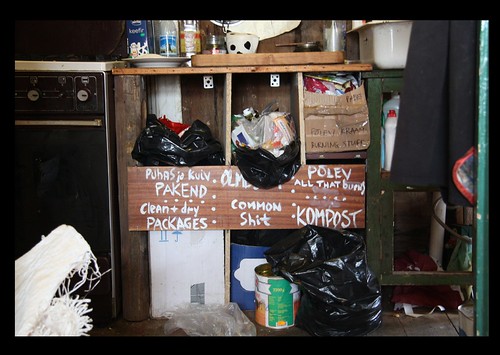clean and tidy
by environmentalist Rachael
Tallinn, Estonia
Again we’re surprised at how an imaginary line can cause everything to be instantly different. On one side, where we’ve just come from, is a roller-coaster-bumpy road lined with pines and birch trees. Russia 😉
As we wait in the queue at the line called a border we see the first trees with new green leaves. Spring has reached Estonia.
Across the line is a beautiful town; Narva, according to the sign. Set on a river or perhaps sea inlet (we’re not sure), church spires poke up from solid old stone fortress walls. It’s fairytale beautiful and we expect to see Cinderella walk by.
Russia might still think Estonia is hers, but a decade and a half of freedom from what-was-always-illegal-Russian-control has been time enough to make this a different place. For a start, the birch trees thin out! The road turns smooth, the grass is green and well-tended in public spaces. Buildings are neat and tidy. Fences, straight and made from palings (as opposed to any old scraps of anything). Gardens are being prepared. Every back yard is full of dark newly-turned earth. I suppose, to be fair to Russia, it will look the same there when the snow has gone in a couple of weeks.
Farmhouses, stone and wooden, dot the countryside. Hay bales sit rolled in fields. We pass a wind farm. Pine forests thicken. Small purple flowers brighten the forest floor. A little (very little) snow lingers in the shade. Some roads off the main one are dirt – but they look smooth. Even the ramshackle falling-down buildings look quaint rather than dishevelled. A bit further on houses sit in fenced quarter acre yards, almost New Zealand-like (but with the number of fruit trees and vegetable gardens it is a NZ of yesteryear, my childhood growing space – not the relatively cramped cross-leased infill-housing of today).
First impressions are that Estonia is a tidy place. Digging deeper we find out this is not entirely true – or at least it has not always been so. Almost exactly a year ago this was the site of a massive CLEANUP campaign – in one day over 50,000 people took to the streets, forests and waterways, and removed 10,000 tonnes of illegal waste with the help of more than 40 waste management companies, who then recycled 80% of the rubbish. You can see all sorts of inspirational details right here. I had read about this while still in New Zealand, not for one moment realising we would end up staying with some of the organisers! But here we are in a composting recycling home in the heart of Tallinn talking to guys who were instrumental in the Let’s Do It cleanup campaign last year, and who are currently working on the anniversary project about to take place this weekend. After sighing our way through Asia’s plastic bag strewn environment, this has been a welcome change. And it is encouraging to see what even a small group of volunteers can do.

Now I need to ask them – and you – about the practice of burning agricultural ground. We have seen it done all the way from Laos to Mongolia….right across Russia we saw the slow lines of ground level fire…and driving into Estonia we fought through the thickest smoke. Had this burn-off got out of control? Possible – there *were* fire appliances in attendance. Was it supposed to be so smoky? (others hadn’t been) What is it done for? Is it our equivalent of digging in potash? And if so, is our version any more ecologically sound just because we don’t witness the smoke? I really did wonder how good it is for the environment seeing the clouds of smoke hanging over the fields. But I don’t know. Can anyone enlighten me?
Tags: health, housing, learning, postcard: Estonia, postcard: Russia, transport




Hi there I have really enjoyed ‘traveling’ along with you on your journey.
We do still have burn off’s in New Zealand. There are rules controlling their use particularly because of smoke near state highways causing traffic problems as well as so that they don’t get out of control in dry windy conditions.
I not sure why it gets done something about returning the nutrients to the soil for the next years crops.
from what i understand (ie no expert) it is a traditional method of acquiring carbon to enrich your soil, as well of dealing to garden waste of course.. if done ‘properly’ there should be pretty much no smoke, due to efficient burning, but as with so many other things people don’t necessarily have the time/skill/knowledge/inclination/luck/manageable scale to do things perfectly 😉 it’s certainly regaining popularity amongst the eco-set in nz, US & UK!
As far as I’m aware, it’s a traditional (in England) way of gettting rid of the stubble left after the crop has been harvested. The ash is then ploughed into the soil, ready for planting the next crop – clean up and fertilise in one process. In the North of England and Scotland, they also burn heather to stimulate new growth. When I visited the Blue Mountains in Australia, I was told that the local Aboriginal tribe used to do controlled burning of the forests tens of thousands of years ago, also to stimulate new growth.
Glad you got the computer sorted, I was missing your updates!